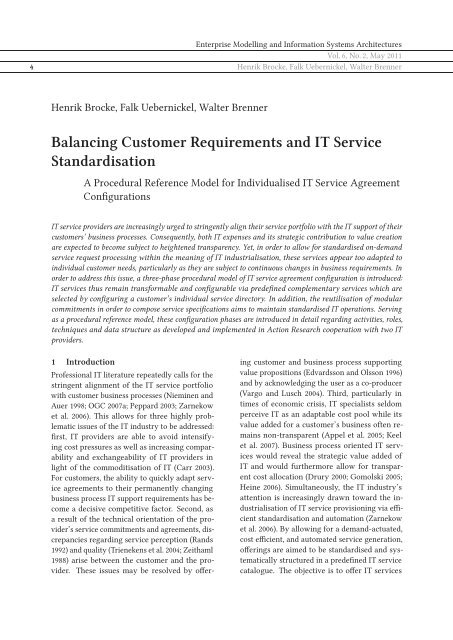Kundenorientierte Gestaltung und Vereinbarung standardisierter IT ...
Kundenorientierte Gestaltung und Vereinbarung standardisierter IT ...
Kundenorientierte Gestaltung und Vereinbarung standardisierter IT ...
Erfolgreiche ePaper selbst erstellen
Machen Sie aus Ihren PDF Publikationen ein blätterbares Flipbook mit unserer einzigartigen Google optimierten e-Paper Software.
Enterprise Modelling and Information Systems Architectures<br />
Vol. 6, No. 2, May 2011<br />
4 Henrik Brocke, Falk Uebernickel, Walter Brenner<br />
Henrik Brocke, Falk Uebernickel, Walter Brenner<br />
Balancing Customer Requirements and <strong>IT</strong> Service<br />
Standardisation<br />
A Procedural Reference Model for Individualised <strong>IT</strong> Service Agreement<br />
Configurations<br />
<strong>IT</strong> service providers are increasingly urged to stringently align their service portfolio with the <strong>IT</strong> support of their<br />
customers’ business processes. Consequently, both <strong>IT</strong> expenses and its strategic contribution to value creation<br />
are expected to become subject to heightened transparency. Yet, in order to allow for standardised on-demand<br />
service request processing within the meaning of <strong>IT</strong> industrialisation, these services appear too adapted to<br />
individual customer needs, particularly as they are subject to continuous changes in business requirements. In<br />
order to address this issue, a three-phase procedural model of <strong>IT</strong> service agreement configuration is introduced:<br />
<strong>IT</strong> services thus remain transformable and configurable via predefined complementary services which are<br />
selected by configuring a customer’s individual service directory. In addition, the reutilisation of modular<br />
commitments in order to compose service specifications aims to maintain standardised <strong>IT</strong> operations. Serving<br />
as a procedural reference model, these configuration phases are introduced in detail regarding activities, roles,<br />
techniques and data structure as developed and implemented in Action Research cooperation with two <strong>IT</strong><br />
providers.<br />
1 Introduction<br />
Professional <strong>IT</strong> literature repeatedly calls for the<br />
stringent alignment of the <strong>IT</strong> service portfolio<br />
with customer business processes (Nieminen and<br />
Auer 1998; OGC 2007a; Peppard 2003; Zarnekow<br />
et al. 2006). This allows for three highly problematic<br />
issues of the <strong>IT</strong> industry to be addressed:<br />
first, <strong>IT</strong> providers are able to avoid intensifying<br />
cost pressures as well as increasing comparability<br />
and exchangeability of <strong>IT</strong> providers in<br />
light of the commoditisation of <strong>IT</strong> (Carr 2003).<br />
For customers, the ability to quickly adapt service<br />
agreements to their permanently changing<br />
business process <strong>IT</strong> support requirements has become<br />
a decisive competitive factor. Second, as<br />
a result of the technical orientation of the provider’s<br />
service commitments and agreements, discrepancies<br />
regarding service perception (Rands<br />
1992) and quality (Trienekens et al. 2004; Zeithaml<br />
1988) arise between the customer and the provider.<br />
These issues may be resolved by offer-<br />
ing customer and business process supporting<br />
value propositions (Edvardsson and Olsson 1996)<br />
and by acknowledging the user as a co-producer<br />
(Vargo and Lusch 2004). Third, particularly in<br />
times of economic crisis, <strong>IT</strong> specialists seldom<br />
perceive <strong>IT</strong> as an adaptable cost pool while its<br />
value added for a customer’s business often remains<br />
non-transparent (Appel et al. 2005; Keel<br />
et al. 2007). Business process oriented <strong>IT</strong> services<br />
would reveal the strategic value added of<br />
<strong>IT</strong> and would furthermore allow for transparent<br />
cost allocation (Drury 2000; Gomolski 2005;<br />
Heine 2006). Simultaneously, the <strong>IT</strong> industry’s<br />
attention is increasingly drawn toward the industrialisation<br />
of <strong>IT</strong> service provisioning via efficient<br />
standardisation and automation (Zarnekow<br />
et al. 2006). By allowing for a demand-actuated,<br />
cost efficient, and automated service generation,<br />
offerings are aimed to be standardised and systematically<br />
structured in a predefined <strong>IT</strong> service<br />
catalogue. The objective is to offer <strong>IT</strong> services

















